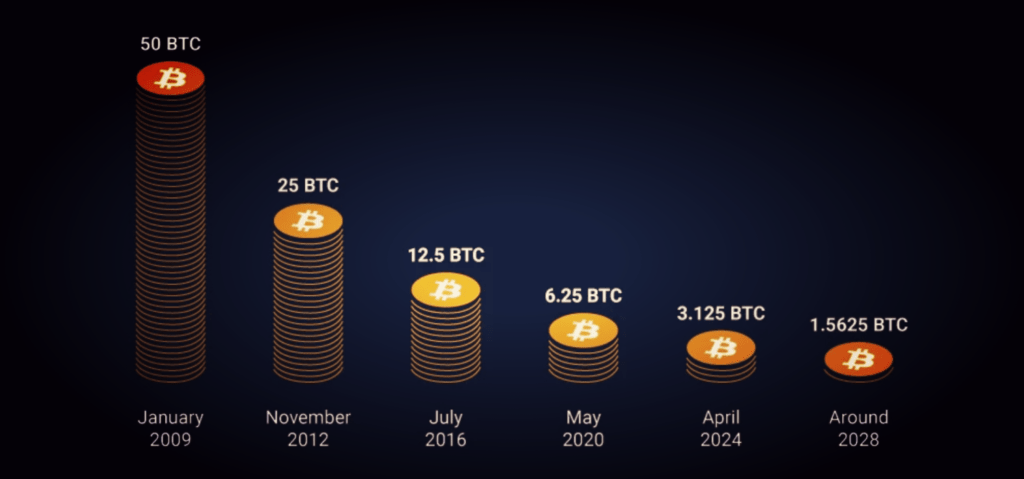In the world of cryptocurrency, one name stands out above the rest: Bitcoin. As the first decentralized digital currency, Bitcoin has been the pioneer and standard-bearer of the industry since its inception in 2008. Despite the rise of numerous alternative cryptocurrencies, Bitcoin remains the most widely recognized and widely used digital currency, with a rich history, unique features, and a wide range of uses.
Bitcoin’s market capitalization often dictates the overall sentiment and trends within the broader cryptocurrency market. When Bitcoin’s price rises, other cryptocurrencies tend to follow suit, and vice versa. In this article, we will learn about Bitcoin, review how it works, its key features and benefits, and its various use cases, as well as the challenges and controversies surrounding it.
History of Bitcoin

The genesis of Bitcoin can be traced back to 2008, when a mysterious individual or group known as Satoshi Nakamoto released a groundbreaking whitepaper titled “Bitcoin: A Peer-to-Peer Electronic Cash System.” This document outlined a revolutionary concept: a decentralized, digital currency that could be transferred directly between users without the need for intermediaries like banks. The whitepaper proposed a system that would be secure, transparent, and resistant to censorship, addressing the shortcomings of traditional financial systems.
Nakamoto’s whitepaper detailed the technical underpinnings of Bitcoin, including its underlying technology, the blockchain, and the process of mining. It introduced the concept of a decentralized network, where transactions are verified and added to a public ledger, ensuring security and immutability. The whitepaper also established the limited supply of Bitcoin, with a maximum of 21 million coins ever to be created, a key aspect about Bitcoin that ensures scarcity and potential value appreciation.
As part of our Bitcoin review, it’s worth noting that Satoshi Nakamoto’s whitepaper served as a blueprint for the creation of Bitcoin, laying the foundation for a new era in digital currency. The first block in the Bitcoin blockchain, known as the Genesis Block, was mined on January 3, 2009, and the first transaction took place on January 12, 2009, when Satoshi Nakamoto sent 10 Bitcoins to Hal Finney, a prominent early Bitcoin developer.
In the early days of Bitcoin, transactions were few and far between, but the currency gained popularity in 2010 with the launch of the first online exchange, the New Liberty Standard Exchange. One of the most fascinating aspects about Bitcoin is its early adoption by a small group of enthusiasts who conducted transactions on the network, drawn by the concept of a digital currency free from government control and traditional financial institutions. These pioneers explored the potential of Bitcoin for peer-to-peer payments and online purchases.

When learning about Bitcoin, it’s essential to understand the significant milestones that have shaped the cryptocurrency’s development and adoption. One of the most significant events in Bitcoin’s history was the rise and fall of the Silk Road, a dark web marketplace that used Bitcoin as its primary means of exchange. The Silk Road was shut down by law enforcement in 2013, but not before it had helped to establish Bitcoin as a viable means of exchange. The closure of the Silk Road brought increased scrutiny to Bitcoin and its association with criminal activity, spurring discussions about the need for regulation of cryptocurrency. However, it also highlighted Bitcoin’s potential for anonymity and cross-border payments, a topic we’ll explore further in our Bitcoin review.
Another key event was the Mt. Gox hack in 2014, which resulted in the loss of hundreds of thousands of Bitcoins, highlighting the vulnerabilities of early cryptocurrency exchanges and the importance of security measures to safeguard digital assets. This event led to a significant decline in the currency’s value. Despite these challenges, Bitcoin’s popularity continued to grow. As Bitcoin matured, it attracted institutional investors, large corporations, and government entities, all of whom were eager to learn more about Bitcoin and its potential applications.
How Bitcoin Works
Bitcoin is built on a decentralized network of computers that work together to record transactions and manage the currency’s supply. The underlying technology behind Bitcoin is known as blockchain, a public ledger that records all transactions made on the network. Think of it as a digital, distributed record-keeping system, shared across a network of computers. This network is not controlled by any single entity, which is a key aspect about Bitcoin’s decentralized nature.
Each block in the blockchain contains a collection of recent transactions, along with a timestamp and a hash of the previous block. This creates a chain of blocks, linked together by their unique hashes, making it extremely difficult to alter or tamper with the data. Every time a new transaction is added, it’s broadcast to the network and verified by miners. Once verified, the transaction is added to the next block, which is then added to the blockchain. This process ensures that the blockchain remains secure and tamper-proof.
The process of verifying transactions and adding them to the blockchain is known as mining. One of the most interesting aspects about Bitcoin is the way it’s mined. Miners compete with each other to solve the mathematical problems, and the first miner to solve the problem gets to add a new block of transactions to the blockchain and is rewarded with newly minted Bitcoins. This process ensures the security of the network and incentivizes individuals to contribute to the validation of transactions. The more miners are active, the more secure the network becomes.
Once the transaction is verified and added to the blockchain, it becomes permanent and cannot be reversed. The confirmation process can take anywhere from 10 minutes to 24 hours, depending on the network’s congestion and the transaction fees paid. The higher the fee, the faster the transaction will be confirmed. Currently, a fee of around $1 is required to make a fast transaction, but during periods of high market activity, fees can surge to as high as $30 or more.
About Bitcoin Mining: How it Works and Why it Matter
Bitcoin mining has evolved significantly since the early days of the currency. Initially, mining was done on the CPUs of regular computers, but as the difficulty of the mathematical problems increased, miners began to use graphics processing units (GPUs) to speed up the process. Today, most mining is done using specialized computers called application-specific integrated circuit (ASIC) miners, which are designed specifically for Bitcoin mining.
ASICs are specialized hardware designed for a single purpose, in this case, Bitcoin mining. They offer significantly more processing power and efficiency than CPUs or GPUs, making them the dominant force in Bitcoin mining today.
The difficulty of the mathematical problems is adjusted every 2016 blocks, or approximately every two weeks, to ensure that the time it takes to mine a new block remains constant. This adjustment is known as the bitcoin difficulty, and it has increased significantly over the years as more miners have joined the network.
The use of ASICs has significantly increased the hash rate of the Bitcoin network, making it more secure and resistant to attacks. However, the rise of ASICs has also made mining less accessible for individuals, as the cost of these specialized machines can be prohibitively expensive.
The development of ASICs has led to a consolidation of Bitcoin mining power among large mining pools and companies. These entities have the resources to acquire and operate large-scale mining operations, making it challenging for individuals to compete. While ASICs have made Bitcoin mining more efficient and secure, they have also raised concerns about centralization and the potential for a small number of entities to control a significant portion of the network’s hash rate.
Features and Benefits of Bitcoin

Bitcoin has several key features that make it an attractive currency. One of the most significant is its decentralization, which means that it is not controlled by any government or institution. This makes it resistant to censorship and manipulation, and allows for peer-to-peer transactions without the need for intermediaries.
The decentralized nature of the Bitcoin network makes it resilient to attacks. There is no single point of failure that could be exploited to compromise the network, making it more secure than traditional centralized systems. Bitcoin is also highly secure, thanks to the use of advanced cryptography, the decentralized nature of the network, and its significant hash power. It is considered one of the most secure digital currencies available.
Another key feature about Bitcoin is its limited supply. There will only ever be 21 million Bitcoins in existence, which makes it a scarce asset. This scarcity, combined with its growing demand, has driven up the price of Bitcoin over the years.
The benefits of using Bitcoin include fast and global transactions, low fees compared to wire transfers, and resistance to censorship means that users can transact freely, without interference from governments or other entities. Bitcoin transactions are processed in real-time, regardless of the location of the sender and recipient, and the fees are most of the time lower than those of traditional payment systems.
Uses of Bitcoin
Bitcoin has a diverse range of use cases, including serving as a store of value, investment, speculation, remittances, and online commerce. Many people review Bitcoin as a digital equivalent of gold, investing in it as a hedge against inflation or economic uncertainty.

One of the most important things to know about Bitcoin is its fixed supply, capped at 21 million, which makes it resistant to inflation, unlike fiat currencies that can be devalued through excessive printing. Additionally, Bitcoin’s decentralized nature, with no central authority controlling its supply or value, enhances its appeal as a store of value, as it’s not subject to government manipulation or intervention.
Although Bitcoin’s price has experienced significant fluctuations, its long-term growth potential continues to attract investors, particularly those seeking to diversify their portfolios beyond traditional assets like stocks and bonds. The increasing adoption of Bitcoin by institutional investors, such as hedge funds and asset management firms, lends credibility to its legitimacy as an investment asset. These institutions bring their expertise and resources to the cryptocurrency market, contributing to its growth and development. While volatility remains a concern for some investors, proponents argue that Bitcoin’s long-term growth potential outweighs the risks.
Some individuals use Bitcoin for speculation, buying and selling the currency in the hopes of making a profit. The price of Bitcoin can fluctuate dramatically, driven by factors such as news events, market sentiment, regulatory changes, and adoption rates. This volatility creates opportunities for both profit and loss, attracting speculators who seek to capitalize on short-term price movements.
Bitcoin is also used for remittances, enabling people to send money across borders quickly and affordably. Online commerce is another significant use case, with many merchants beginning to review Bitcoin as a viable form of payment.
One of the lesser-known facts about Bitcoin is that, due to significantly increased fees in recent years, microtransactions are no longer a practical use case for the cryptocurrency.
The Bitcoin 4-Year Cycle
One of the most fascinating aspects about Bitcoin market is the 4-year cycle, which is driven by the halving events that occur approximately every four years. These events reduce the reward for miners, who verify transactions and create new blocks, by half. This reduction in supply has a profound impact on the price of Bitcoin, as it creates a scarcity effect that can drive demand and potentially increase its value.

The halving events have a significant impact on the price of Bitcoin, as the reduced reward for miners leads to a decrease in the number of new Bitcoins being created. This scarcity effect can drive up demand, as investors and speculators anticipate that the limited supply will increase the price of Bitcoin. Historically, the halving events have been followed by periods of price growth, as investors and traders anticipate the scarcity effect.
The 4-year cycle is divided into two phases: the bull phase and the bear phase. The bull phase is characterized by increasing price and market capitalization, growing adoption and mainstream recognition, and improving sentiment and investor confidence. The bear phase, on the other hand, is characterized by decreasing price and market capitalization, decreasing adoption and mainstream recognition, and decreasing sentiment and investor confidence.
The 2013, 2017 and 2021 rallies are examples of the bull phase, during which the price of Bitcoin increased significantly and the currency gained widespread recognition. In contrast, the 2018 and 2022 corrections are examples of the bear phase, during which the price of Bitcoin decreased significantly and the currency faced significant challenges.

Challenges and Controversies
Despite its many benefits, Bitcoin faces several challenges and controversies. One of the most significant is the slow transaction confirmation times, which can make it impractical for small transactions. Another challenge is the mempool congestion and high transaction fees during mania phase of the crypto market, which can make it expensive to use the network.
There are potential solutions to these challenges, including increasing the block size limit and implementing second-layer scaling solutions such as the Lightning Network.
Conclusion
In conclusion, Bitcoin is the original and still the most popular cryptocurrency, with a rich history, unique features, and a wide range of uses. Its decentralization, security, and limited supply make it an attractive currency for investors and users alike. Despite the challenges and controversies surrounding it, Bitcoin remains a significant player in the cryptocurrency market and is likely to continue to shape the future of digital currency. As the cryptocurrency market continues to evolve, it will be interesting to see how Bitcoin adapts and grows, and whether it will remain the dominant player in the market.










